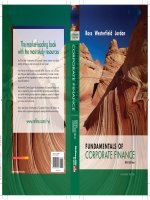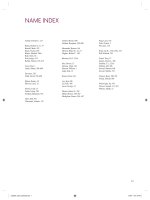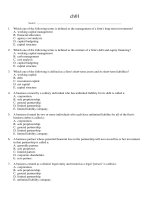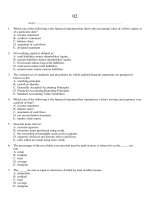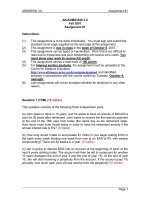assignment12 fundamentals of corporate finance, 4th edition brealey
Bạn đang xem bản rút gọn của tài liệu. Xem và tải ngay bản đầy đủ của tài liệu tại đây (153.6 KB, 12 trang )
AK/ADMS3530 3.0
Assignment #2 Solutions
Winter 2007
Question 1 (18 marks)
Blooper Technology Inc. is considering purchasing two machines, A and B, which
are expected to generate $36,000 and $40,000 respectively in cash flows per
year for 5 years. Although Machine B is more expensive than Machine A, its
payback period (3.25 years) is shorter compared to that of Machine A (3.5
years). Blooper’s opportunity cost of capital is 10%.
(a) Which machine would you take if the machines were mutually exclusive
and if shareholder maximization were your basis for decision? Explain. (5
Marks)
Answer
COST OF MACHINE A= 3.50 × 36,000 = $126,000
COST OF MACHINE B= 3.25 × 40,000 = $130,000
NPV A = -126,000 + 36,000 (PVIFA 5, 10%) = $10,468.32
NPV B = -130,000 + 40,000 (PVIFA 5, 10%) = $21,631.47
MACHINE B SINCE IT HAS A GREATER NPV.
(b) If the company is willing to accept any project with a discounted payback
period less than 4.25 years, would you recommend buying these
machines? Explain. (4 Marks)
Answer
(CASH FLOWS IN THOUSANDS OF DOLLARS)
0
1
2
3
4
5
-126
36
36
36
36
36
$32.73 $29.75 $27.05 $24.59 $22.35
DISCOUNTED PAYBACK A=4.53 YEARS
0
-130
REJECT
BECAUSE DPB > 4.25
1
2
3
4
5
40
40
40
40
40
$36.36 $33.06 $30.05 $27.32 $24.84
DISCOUNTED PAYBACK B= 4.13 YEARS
ACCEPT
BECAUSE DPB < 4.25
ADMS3530 3.0
Assignment #2 solutions
(c) Calculate the internal rate of return on each machine. Would you buy
these machines based on IRR? Explain. (3 Marks)
Answer
IRR OF MACHINE A: 13.20 % (PV=-126, PMT=36, FV=0, N=5, I=?)
IRR OF MACHINE B: 16.32 % (PV=-130, PMT=40, FV=0, N=5, I=?)
YES. BOTH IRRS ARE GREATER THAN THE COST OF CAPITAL.
(d) Machine A comes with an optional module which extends its useful life 2
more years (with the same annual cash flows of $36,000) at an additional
initial cost of $20,000. Which machine should you take after considering
this option? ( 6 Marks)
Answer
THE PV OF THE CF STREAM FROM MACHINE A = -146 +36 X (PVIFA 7, 10%)
= -146 + 36 × 4.8684
= $29,263.08
EQUIVALENT ANNUAL CF FROM A= $29,263.08 / 4.8684 = $6,010.82
THE PV OF THE CF STREAM FROM MACHINE B= -130 + 40 × (PVIFA 5, 10%)
= -130 + 40 × 3.7908
= $21,631.47
EQUIVALENT ANNUAL CF FROM B= $21,631.47 / 3.7908 = $5,707.31
CHOSE MACHINE A.
Question 2 (10 marks)
Calculate the NPV for the following capital budgeting proposal: $110,000 initial
cost, to be depreciated straight-line over five years to an expected salvage value
of $5,000, 35 percent tax rate, $35,000 additional annual revenues, $5,000
additional annual expense, $7,000 additional investment in working capital today
to be recovered in year 5. Project has a 9 percent cost of capital. Assume that
the CCA is same as depreciation.
Answer
(Cash flows are in dollars)
Page 2
ADMS3530 3.0
Assignment #2 solutions
Year 0
Year 1
Year 2
Year 3
Year 4
Year 5
Cost
(110,000)
Change in
Working Capital
(7,000)
7,000
Revenues
35,000
35,000
35,000
35,000
35,000
5,000
5,000
5,000
5,000
5,000
21,000
21,000
21,000
21,000
21,000
9,000
9,000
9,000
9,000
16,000
3,150
3,150
3,150
3,150
5,600
5,850
5,850
5,850
5,850
10,400
less Expenses
less
Depreciation
= Net Inc.
less Taxes
(35%)
= NI After Tax
Salvage Value
5,000
Cash Flows
(117,000)
26,850
26,850
26,850
26,850
36,400
NPV of Project = PV of Cash Flows - Initial Investment
NPV = $26,850
1
1
−
4
.09 .09(1.09)
$36,400
(1.09)5
+
- $117,000 = -$6,356.02
Given that the NPV is negative, you reject the project.
Alternatively,
(Cash flows are in dollars)
Year 0
Year 1
Year 2
Year 3
Year 4
Year 5
Cost
(110,000)
Change in
Working Capital
(7,000)
7,000
Revenues
35,000
35,000
35,000
35,000
35,000
5,000
5,000
5,000
5,000
5,000
21,000
21,000
21,000
21,000
21,000
9,000
9,000
9,000
9,000
9,000
less Expenses
less
Depreciation
= Net Inc.
Page 3
ADMS3530 3.0
Assignment #2 solutions
less Taxes
(35%)
= NI After Tax
3,150
3,150
3,150
3,150
3,150
5,850
5,850
5,850
5,850
5,850
Salvage Value
5,000
Cash Flows
(117,000)
26,850
26,850
26,850
26,850
38,850
NPV of Project = PV of Cash Flows - Initial Investment
NPV = $26,850
1
1
−
4
.09 .09(1.09)
$38,850
(1.09)5
+
- $117,000 = -$4,763.68
Given that the NPV is negative, you reject the project.
Both answers will be considered as valid.
Question 3 (14 marks)
The Atkinson College Entrepreneurship Team (ACET) is consulting to New
Venture Skis Inc. (NVS) who has designed a new top of the line ski. The skis
are expected to retail at $600 with a profit margin (PM) of 60%.
The first round of consulting to NVS, concluded earlier in the year, had been
billed to NVS for $150,000. The research indicated that NVS would sell
50,000 sets of the new skis per year for 7 years which will reduce 12,000 sets
of projected sales per year from the current high end line of skis. These high
end skis sell for $1,000 with a variable cost of $550. However sales of the
firm’s least expensive $300 skis will increase annually by 10,000 sets at a
33.3% PM.
Fixed costs are $7 million annually. One million dollars has been spent on
research and development of the new $600 skis. New plant and equipment
will cost $15,400,000 and has a 30% CCA rate and an expected salvage of
$2 million. Net working capital will increase by $900,000 annually that will be
returned at the end of the project. NVS has a 40% tax rate and a 14% cost of
capital. The half-year rule applies. Compute the following for NVS:
(a)
Payback period. (3 marks)
Answer
The marketing study and the research and development are both sunk
costs and should be ignored.
Page 4
ADMS3530 3.0
Sales
New skis
Expensive
skis
Cheap skis
Total
Var. costs
New skis
Expensive
skis
Cheap skis
Total
Assignment #2 solutions
$600 × 50,000 = $30,000,000
$1,000 × (– 12,000) = –$12,000,000
$300 × 10,000 =
$21,000,000
$3,000,000
$240 × 50,000 = $12,000,000
$550 × (–12,000) = –$6,600,000
$200 × 10,000 =
$7,400,000
$2,000,000
For the next 4 years:
Sales
Variable costs
Fixed costs
CCA
EBIT
Taxes
Net income
Year 1
$21,000,000
7,400,000
7,000,000
2,310,000
4,290,000
1,716,000
$ 2,574,000
Year 2
$21,000,000
7,400,000
7,000,000
3,927,000
2,673,000
1,069,200
$1,603,800
Year 3
$21,000,000
7,400,000
7,000,000
2,748,900
3,851,100
1,540,440
$2,310,660
Year 4
$21,000,000
7,400,000
7,000,000
1,924,230
4,675,770
1,805,462
2,805,462
The half-year rule has been incorporated into the calculation of the annual
CCA. To accurately calculate the payback period, we need to estimate the
operating cash flows in the first four years. These can be determined
from the following relationship (for this part depreciation is assumed to be
the same as the CCA) :
OCF1 = NI + D = $(2,574,000 + 2,310,000) = $4,884,000
OCF2 = NI + D = $(1,603,800 + 3,927,000) = $5,530,800
OCF3 = NI + D = $(2,310,660 + 2,748,900) = $5,059,560
OCF4 = NI + D = $(2,805,462 + 1,924,230) = $4,729,692
The initial cost is made up of the cost of the plant and equipment plus the
increase in net working capital in Year 0:
= $15.4M + 0.9M = $16.3M
The sum of the OCFs in the first 3 years is: $ $15,474,360
So the payback period = 3 years + $(16,300,000 – 15,474,360) / $4,729,692
= 3.175 years.
(b)
NPV. (6 marks)
Answer
To find the NPV and IRR we need the after-tax net revenue each year as
Page 5
ADMS3530 3.0
Assignment #2 solutions
well as the present value of the CCA tax shield and the initial and ending
cash flows.
Initial cash flow = -$(15,400,000 + 900,000) = -$16,300,000
After-tax net revenue in Years 1-7 = (S – C)(1 – Tc)
= $(21,000,000 – 14,400,000)(1 – 0.4)
= $3,960,000
Ending cash flows (Year 7) = recovery of NWC + salvage value =
$900,000 + 2,000,000 = $2,900,000
PV of CCATS = 15,400,000(0.3)(0.4) x (1 + 0.5(0.14))
0.14 +0.3
1 +0.14
-2,000,000(0.3)(0.4) x
1
0.14 + 0.3
(1.14)7
= $3,724,121
NPV = –$16.3M + $3.96M (PVIFA14%,7) + $3,724,121 + $2.9M/1.147
= $5,307,458
Alternatively, the after-tax net revenue in Years 1-7 = $3,960,000 –
$900,000 (change in NWC annually) = $3,060,000
NPV = –$16.3M + $3.06M (PVIFA14%,7) + $3,724,121 + $2.9M/1.147
= $1,705,282
Both NPV figures are acceptable for this question.
(c)
IRR. (5 marks)
Answer
To simplify the IRR calculation, it is assumed that CCA tax shield cash
flows are as risky as the cash flows for the company’s overall operations.
Accordingly, the appropriate discount rate for the CCA tax shield is the
company’s cost of capital. The PV of CCATS is thus the same as for the
NPV calculation.
NPV = 0 = –$16.3M + $3.96M (PVIFAIRR%,7) + $3,724,121 + $2.9M/(1 +
IRR)7 ⇒ IRR ≅ 26.6%
Alternatively,
NPV = 0 = –$16.3M + $3.06M (PVIFAIRR%,7) + $3,724,121 + $2.9M/(1 +
IRR)7 ⇒ IRR ≅ 18%
Again both values of IRR are considered correct.
Page 6
ADMS3530 3.0
Assignment #2 solutions
Question 4 (17 marks)
Another consulting assignment on which the ACET is working is with Keep You
Warm Corp (KYC), who has asked ACET for an evaluation of a six year
$924,000 project to sell hi-tech ski glove warmers. There is a zero salvage value
on the project assets which use straight-line depreciation (to zero). Assume that
the CCA is the same as depreciation. The new hi-tech glove warmers will sell for
$34 with a variable cost of $19. Sales are expected to be 130,000 pairs of
gloves per year. Fixed costs are $800,000 per year. KYC has a 35% tax rate
and a 15% cost of capital. Consider this as the base case scenario.
(a)
Calculate the accounting breakeven and the degree of operating leverage
at that point. (4 marks)
Answer
Depreciation = $924,000/6 = $154,000 per year
The profit margin = $(34-19)/$34 = $0.4412
Accounting break even sales = ($800,000 + $154,000)/($0.4412) =
$2,162,285
The following two answers are both acceptable for the DOL:
1) at the accounting break even sales level, the net income is 0, so the
operating cash flow (OCF) = 0 + depreciation (D) = $154,000
So DOL = 1 + FC/OCF = 1 + FC/D
= 1 + [$800,000+$154,000]/$154,000 = 7.195
Alternatively, 2)
DOL = 1 + FC/profits = ∞ since profits are zero.
(b)
What is the sensitivity of Operating Cash Flows to change in the variable
cost figure? What does your answer suggest about a $1 reduction in the
variable costs? (5 marks)
Answer
VCnew = $18 (i.e. $1 reduction)
OCFnew = [($34 – $18)(130,000) – $800,000](0.65) + 0.35($154,000) =
$885,900
OCFbase = [($34 – $19)(130,000) – $800,000](0.65) + 0.35($154,000) =
$801,400
∆OCF/∆VC = ($885,900 – $801,400) / ($18 – 19) = –$84,500
So if variable costs fell by $1, then the OCF would rise by $84,500.
(c)
Calculate the NPV for the base case (most likely scenario) and do a
sensitivity analysis by identifying the best case and worst case scenarios
by changes to the sales numbers. Explain why you selected these
Page 7
ADMS3530 3.0
Assignment #2 solutions
numbers and what the impacts may be on your decision as to whether or
not to move forward with the project. (8 marks)
Answer
NPVbase
= –$924,000 + $801,400(PVIFA15%,6) = $2,108,884.43
Answers to the sensitivity analysis will vary.
For example if sales rise by 5,000 units to 135,000 units:
OCFnew = [$(34 – 19)(135,000) – $800,000](0.65) + 0.35($154,000) =
$850,150
NPVnew = –$924,000 + $850,150(PVIFA15%,6) = $2,293,377.96
∆NPV/∆S = ($2,293,377.96 – $2,108,884.43)/($34 × (135,000 –
130,000)) = 1.0853%
In contrast, if sales were to drop by 5,000 units, then the OCF would
drop to: [$(34 – 19)(125,000) – $800,000](0.65) + 0.35($154,000) =
$752,650
NPVnew = –$924,000 + $752,650(PVIFA15%,6) = $1,924,390.90
∆NPV/∆S = ($1,924,390.90 – $2,108,884.43)/($34 × (125,000 –
130,000)) = 1.0853%.
Question 5 (10 marks)
Calculate the expected returns, variances, and standard deviations for stock C,
for stock E, and for a portfolio of both stocks C (2/3 weight) and E (1/3 weight).
Scenario
Probability
Happiness
30%
Indifference
50%
Unhappiness
20%
Return on
C
15%
8%
-4%
Return on
E
-5%
4%
10%
Answer
Stock C :
Expected return = 0.3 × 1 5 % + 0.5 × 8% + 0.2 × ( − 4%) = 7.7%
Variance = 0.3 × (15% - 7.7%) 2 + 0.5 × (8% − 7.7%) 2 + 0.2 × ( − 4% − 7.7%) 2
= 4 3 .41 percentage s squared, or 0.004341
Standard deviation =
43.41 = 6 .59 , or 6.59%
Stock E :
Page 8
ADMS3530 3.0
Assignment #2 solutions
Expected return = 0.3 × ( − 5 %) + 0.5 × 4% + 0.2 × 10 % = 2.5%
Variance = 0.3 × (-5% - 2.5%) 2 + 0.5 × (4% − 2.5%) 2 + 0.2 × (1 0% − 2.5%) 2
= 29 .25 percentage s squared, or 0.002925
Standard deviation =
29.25 = 5 .41 , or 5.41%
Portfolio :
Expected return = 2 / 3 × ( 7 .7 %) + 1 / 3 × ( 2 .5 %) = 5 .97 %
Variance = 0.3 × (8.33% - 5.97%) 2 + 0.5 × (6.67% − 5.97%) 2 + 0.2 × ( 0 .67% − 5.97%) 2
= 7 .5339 percentage s squared, or 0.00075339
Standard deviation =
7.5339 = 2 .74 , or 2.74%
Note that the standard deviation of the portfolio is less than that of either stock C
or stock E because of diversification.
Question 6 (12 marks)
Use the following to answer the questions below:
A market portfolio contains two stocks with the following returns: Aggressive
Stock A, and Defensive Stock D:
Scenario
Bust
Boom
(a)
Market
-8%
32
Rate of Return
Aggressive Stock A
-10%
38
Defensive Stock D
-6%
24
Find the beta of each stock. In what way is stock D defensive? (5 marks)
Answer
Beta is the responsiveness of each stock's return to changes in the market
return.
D is considered to be a more defensive stock than A because its return is
less sensitive to the return of the overall market. In a recession, D will
usually outperform both stock A and the market portfolio.
Page 9
ADMS3530 3.0
(b)
Assignment #2 solutions
If each scenario is equally likely, find the expected rate of return on the
market portfolio and on each stock. (4 marks)
Answer
We take an average of returns in each scenario to obtain the expected
return.
rm = (32% – 8%)/2 = 12%
rA = (38% – 10%)/2 = 14%
rD = (24% – 6%)/2 = 9%
(c)
If the Treasury bill rate is 4 percent, what does the CAPM say about the
fair expected rates of return on the two stocks? (3 marks)
Answer
According to the CAPM, the expected returns that investors will demand of
each stock, given the stock betas and given the expected return on the
market, are:
r = rf + β(rm – rf)
rA = 4% + 1.2(12% – 4%) = 13.6%
rD = 4% + 0.75(12% – 4%) = 10.0%
Question 7 (6 marks)
Calculate the nominal return, real return, and risk premium for the following
common stock investment:
Purchase price
$60.00 per share
Dividend
$3.50 per year
Sales price $73.00 per share
Treasury bill yield 8.5%
Inflation rate 7.5%
ANSWER
NOMINAL RETURN = (CAPITAL GAIN + DIVIDEND) / INITIAL SHARE PRICE
= (73-60 + 3.50) / 60
=27.5 %
REAL RETURN = (1+ NOMINAL RATE) / (1+INFLATION RATE) - 1
= (1.275/1.075) -1
= 18.6%
RISK PREMIUM = NOMINAL RETURN LESS NOMINAL RETURN ON TREASURY BILLS
= 27.5 – 8.5
Page 10
ADMS3530 3.0
Assignment #2 solutions
= 19% IN NOMINAL TERMS
Question 8 (13 marks)
A company issued $35,000,000 of 15-year, 7.5%, $1,000 par value debt at par
three years ago. Assume semi-annual coupon payments. The yield to maturity
on comparable debt today is 9%. The firm also has 6,000,000 common shares
outstanding, which currently trade at $26.00 per share. The firm’s β is 1.26, the
T-bill rate is 3.5% and the market risk premium is 6.7%. Due to the early stage in
its corporate life cycle, the firm has significant tax-loss carry forwards, resulting in
the firm not expecting to have to pay taxes in the foreseeable future.
(a)
Compute the firm’s weighted average cost of capital (WACC). (6 marks)
Answer
The bond price today is:
1
1
$1,000
−
]+
24
0.045 0.045 × (1.045)
(1.045) 24
= $37.5 × 14.4955 + $347.70 = $891.28
$37 .5 × [
The market value of debts (D) = ($35,000,000/$1,000) × $891.28 =
$31,194,800
The market value of equity (E) = $26 × 6,000,000 = $156,000,000
The market value of the firm (V) = D + E = $31,194,800 + $156,000,000 =
= $187,194,800
The cost of equity (requity) is computed using the CAPM as:
requity = 3.5% + 1.26 × 6.7% = 11.94%
The cost of debt (rdebt) is the YTM on bond, which is 9%
So the WACC with no taxes is calculated as:
D
E
× rdebt + × requity
V
V
$31,194,800
$156,000,000
=
× 9% +
× 11.94% = 11.45%
$187,194,800
$187,194,800
WACC =
(b)
If the firm were able to issue an additional $26,000,000 in debt ($1,000 par
value) at an 8.5% coupon rate (paid semi-annually) and use the proceeds
to retire 1,000,000 shares, what would be the firm’s WACC? (4 marks)
Answer
Page 11
ADMS3530 3.0
Assignment #2 solutions
D
E
× rdebt + × requity
V
V
$( 31,194,800 + 26,000,000)
$(156,000,000 − 26,000,000)
=
× 9% +
× 11.94%
$187,194,800
$187,194,800
= 11.04%
Alternatively,
D
E
WACC = × rdebt + × requity
V
V
$31,194,800
$26,000,000
$(156,000,000 − 26,000,000)
=
× 9% +
× 8.5% +
× 11.94%
$187,194,800
$187,194,800
$187,194,800
= 10.97%
Both answers will be considered correct for this question.
WACC =
Note that since debts are typically issued at par, the market value of the
additional debt issue is equal to its par value (book value), which is
$26,000,000.
(c)
How would your answer in part (a) change if the firm were taxable at
35%? (3 marks)
Answer
The WACC with taxes (35%) is calculated as:
D
E
× (1 − TC ) × rdebt + × requity
V
V
$31,194,800
$156,000,000
=
× (1 − 0.35) × 9% +
× 11.94%
$187,194,800
$187,194,800
= 10.93%
WACC =
Page 12


